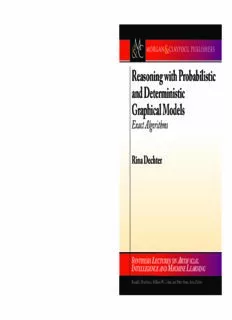Table Of ContentSeries ISSN: 1939-4608 M
D
E
S L A CH &C &
YNTHESIS ECTURES ON RTIFICIAL T Morgan Claypool Publishers
E
R
INTELLIGENCE AND MACHINE LEARNING
Series Editors: Ronald J. Brachman, Yahoo! Research Reasoning with Probabilistic
William W. Cohen, Carnegie Mellon University
Peter Stone, University of Texas at Austin
and Deterministic
R
Reasoning with Probabilistic and E
A
S
O
Deterministic Graphical Models N
IN Graphical Models
G
Exact Algorithms W
IT
H
Rina Dechter, University of California, Irvine P Exact Algorithms
R
O
B
Graphical models (e.g., Bayesian and constraint networks, influence diagrams, and Markov decision processes) A
B
have become a central paradigm for knowledge representation and reasoning in both artificial intelligence and IL
IS
computer science in general. These models are used to perform many reasoning tasks, such as scheduling, T
IC
planning and learning, diagnosis and prediction, design, hardware and software verification, and bioinformatics. A
N
These problems can be stated as the formal tasks of constraint satisfaction and satisfiability, combinatorial D
D
optimization, and probabilistic inference. It is well known that the tasks are computationally hard, but research ET Rina Dechter
E
during the past three decades has yielded a variety of principles and techniques that significantly advanced R
M
the state of the art. IN
IS
T
In this book we provide comprehensive coverage of the primary exact algorithms for reasoning with such IC
G
models. The main feature exploited by the algorithms is the model’s graph. We present inference-based, R
A
message-passing schemes (e.g., variable-elimination) and search-based, conditioning schemes (e.g., cycle- PH
cutset conditioning and AND/OR search). Each class possesses distinguished characteristics and in particular IC
A
L
has different time vs. space behavior. We emphasize the dependence of both schemes on few graph parameters M
O
such as the treewidth, cycle-cutset, and (the pseudo-tree) height. We believe the principles outlined here would D
E
serve well in moving forward to approximation and anytime-based schemes. The target audience of this book L
S
is researchers and students in the artificial intelligence and machine learning area, and beyond.
About SYNTHESIs
This volume is a printed version of a work that appears in the Synthesis
M
Digital Library of Engineering and Computer Science. Synthesis Lectures O
provide concise, original presentations of important research and development R
G
topics, published quickly, in digital and print formats. For more information A
N
visit www.morganclaypool.com
& S L A
YNTHESIS ECTURES ON RTIFICIAL
C
& ISBN: 978-1-62705-197-2 L I M L
Morgan Claypool Publishers 90000 A NTELLIGENCE AND ACHINE EARNING
Y
P
www.morganclaypool.com O
9 781627 051972 O
Ronald J. Brachman, William W. Cohen, and Peter Stone, Series Editors
L
Reasoning with
Probabilistic and Deterministic
Graphical Models:
Exact Algorithms
Synthesis Lectures on Artificial
Intelligence and Machine
Learning
Editors
RonaldJ.Brachman,Yahoo!Research
WilliamW.Cohen,CarnegieMellonUniversity
PeterStone,UniversityofTexasatAustin
ReasoningwithProbabilisticandDeterministicGraphicalModels:ExactAlgorithms
RinaDechter
2013
AConciseIntroductiontoModelsandMethodsforAutomatedPlanning
HectorGeffnerandBlaiBonet
2013
EssentialPrinciplesforAutonomousRobotics
HenryHexmoor
2013
Case-BasedReasoning:AConciseIntroduction
BeatrizLópez
2013
AnswerSetSolvinginPractice
MartinGebser,RolandKaminski,BenjaminKaufmann,andTorstenSchaub
2012
PlanningwithMarkovDecisionProcesses:AnAIPerspective
MausamandAndreyKolobov
2012
ActiveLearning
BurrSettles
2012
iv
ComputationalAspectsofCooperativeGameeory
GeorgiosChalkiadakis,EdithElkind,andMichaelWooldridge
2011
RepresentationsandTechniquesfor3DObjectRecognitionandSceneInterpretation
DerekHoiemandSilvioSavarese
2011
AShortIntroductiontoPreferences:BetweenArtificialIntelligenceandSocialChoice
FrancescaRossi,KristenBrentVenable,andTobyWalsh
2011
HumanComputation
EdithLawandLuisvonAhn
2011
TradingAgents
MichaelP.Wellman
2011
VisualObjectRecognition
KristenGraumanandBastianLeibe
2011
LearningwithSupportVectorMachines
ColinCampbellandYimingYing
2011
AlgorithmsforReinforcementLearning
CsabaSzepesvári
2010
DataIntegration:eRelationalLogicApproach
MichaelGenesereth
2010
MarkovLogic:AnInterfaceLayerforArtificialIntelligence
PedroDomingosandDanielLowd
2009
IntroductiontoSemi-SupervisedLearning
XiaojinZhuandAndrewB.Goldberg
2009
ActionProgrammingLanguages
Michaelielscher
2008
v
RepresentationDiscoveryusingHarmonicAnalysis
SridharMahadevan
2008
EssentialsofGameeory:AConciseMultidisciplinaryIntroduction
KevinLeyton-BrownandYoavShoham
2008
AConciseIntroductiontoMultiagentSystemsandDistributedArtificialIntelligence
NikosVlassis
2007
IntelligentAutonomousRobotics:ARobotSoccerCaseStudy
PeterStone
2007
Copyright©2013byMorgan&Claypool
Allrightsreserved.Nopartofthispublicationmaybereproduced,storedinaretrievalsystem,ortransmittedin
anyformorbyanymeans—electronic,mechanical,photocopy,recording,oranyotherexceptforbriefquotations
inprintedreviews,withoutthepriorpermissionofthepublisher.
ReasoningwithProbabilisticandDeterministicGraphicalModels:ExactAlgorithms
RinaDechter
www.morganclaypool.com
ISBN:9781627051972 paperback
ISBN:9781627051989 ebook
DOI10.2200/S00529ED1V01Y201308AIM023
APublicationintheMorgan&ClaypoolPublishersseries
SYNTHESISLECTURESONARTIFICIALINTELLIGENCEANDMACHINELEARNING
Lecture#23
SeriesEditors:RonaldJ.Brachman,YahooResearch
WilliamW.Cohen,CarnegieMellonUniversity
PeterStone,UniversityofTexasatAustin
SeriesISSN
SynthesisLecturesonArtificialIntelligenceandMachineLearning
Print1939-4608 Electronic1939-4616
Reasoning with
Probabilistic and Deterministic
Graphical Models:
Exact Algorithms
Rina Dechter
UniversityofCalifornia,Irvine
SYNTHESISLECTURESONARTIFICIALINTELLIGENCEANDMACHINE
LEARNING#23
M
&C Morgan &cLaypool publishers
ABSTRACT
Graphical models (e.g., Bayesian and constraint networks, influence diagrams, and Markov de-
cisionprocesses)havebecomeacentralparadigmforknowledgerepresentationandreasoningin
both artificial intelligence and computer science in general. ese models are used to perform
many reasoning tasks, such as scheduling, planning and learning, diagnosis and prediction, de-
sign,hardwareandsoftwareverification,andbioinformatics.eseproblemscanbestatedasthe
formal tasks of constraint satisfaction and satisfiability, combinatorial optimization, and proba-
bilisticinference.Itiswellknownthatthetasksarecomputationallyhard,butresearchduringthe
past three decades has yielded a variety of principles and techniques that significantly advanced
thestateoftheart.
In this book we provide comprehensive coverage of the primary exact algorithms for rea-
soningwithsuchmodels.emainfeatureexploitedbythealgorithmsisthemodel’sgraph.We
presentinference-based,message-passingschemes(e.g.,variable-elimination)andsearch-based,
conditioningschemes(e.g.,cycle-cutsetconditioningandAND/ORsearch).Eachclasspossesses
distinguished characteristics and in particular has different time vs. space behavior. We empha-
sizethedependenceofbothschemesonfewgraphparameterssuchasthetreewidth,cycle-cutset,
and (the pseudo-tree) height. We believe the principles outlined here would serve well in mov-
ing forward to approximation and anytime-based schemes. e target audience of this book is
researchersandstudentsintheartificialintelligenceandmachinelearningarea,andbeyond.
KEYWORDS
graphical models, Bayesian networks, constraint networks, Markov networks,
induced-width, treewidth, cycle-cutset, loop-cutset, pseudo-tree, bucket-
elimination, variable-elimination, AND/OR search, conditioning, reasoning,
inference,knowledgerepresentation
Description:Graphical models (e.g., Bayesian and constraint networks, influence diagrams, and Markov decision processes) have become a central paradigm for knowledge representation and reasoning in both artificial intelligence and computer science in general. These models are used to perform many reasoning task

